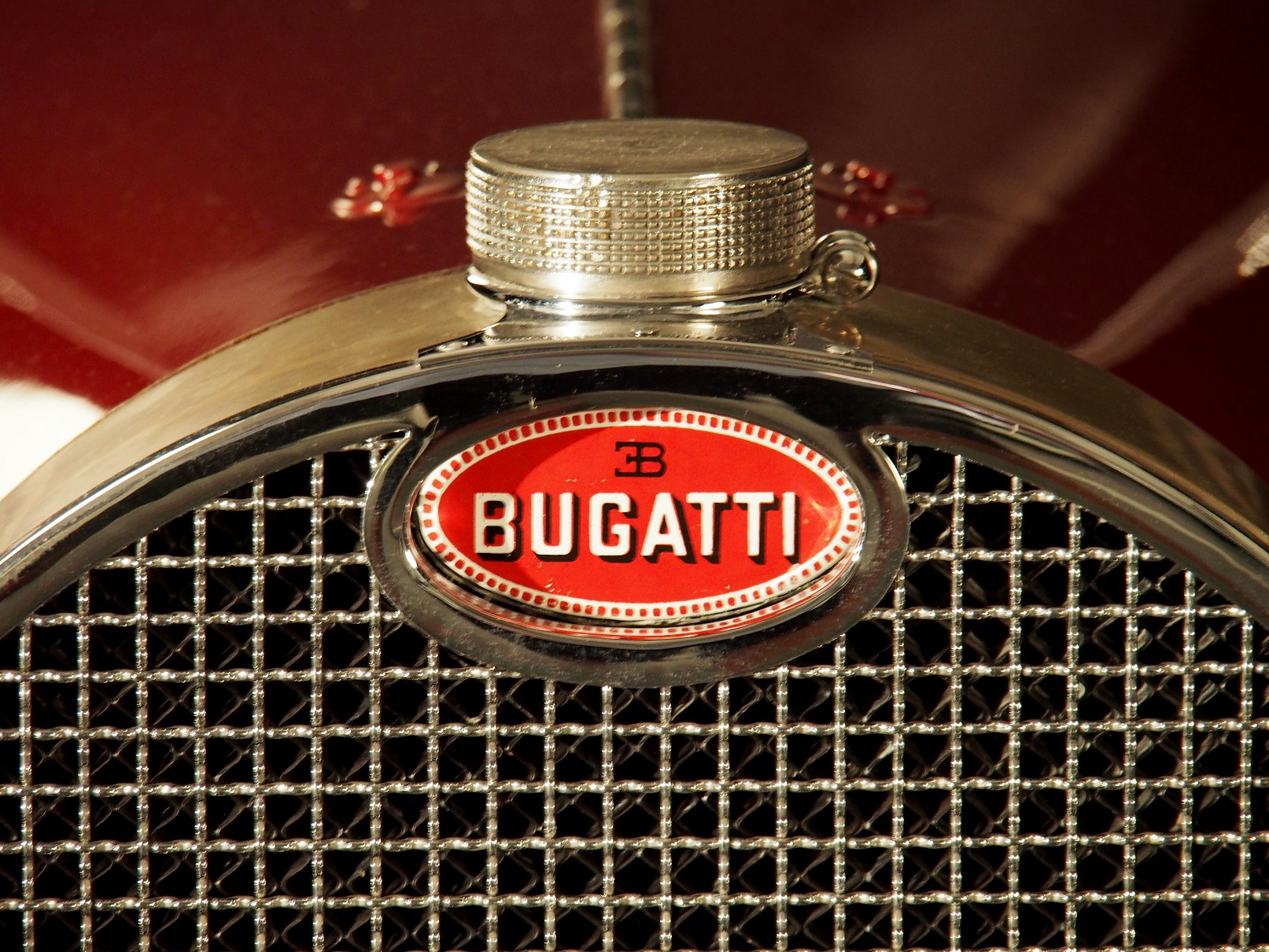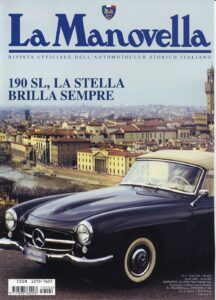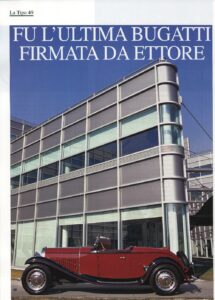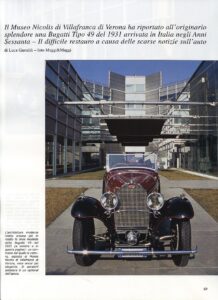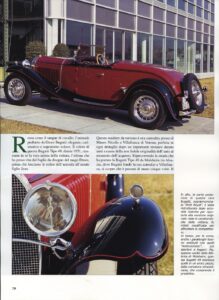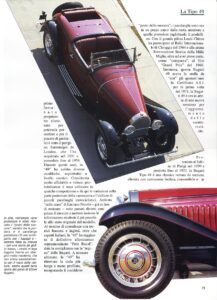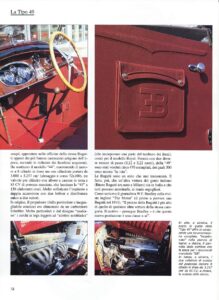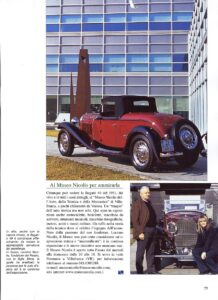Shooting, La Manovella, Bugatti tipo 49
Our 1931 Bugatti Type 49 protagonist of a monographic article by Luca Gastaldi for ‘La Manovella’ ASI.
Photos Maggi & Maggi
It was the last Bugatti signed by Ettore
Museo Nicolis in Villafranca di Verona has restored to its original splendor a 1931 Bugatti Type 49 that arrived in Italy in the 1960s.
The restoration was difficult because there was little information about the car.
Red like horse blood, Ettore Bugatti’s favorite animal: elegant, charismatic, and above all, fast. The colour of this Bugatti Type 49, dated 1931, sums up the true soul of the car, the last to come to life from the drawing sheet of the magician Ettore, before he left the reins of the company to his beloved son Jean. This touring roadster is now housed at the Nicolis Museum in Villafranca di Verona, perfect in every detail after a major restoration that lasted years due to the car’s untruthful originality at the time of purchase. Retracing the route that brought the Bugatti Type 49 from Molsheim (in Alsace, where Bugatti founded his company) to Villafranca, it turns out that it changed hands five times. The first lucky owner (lucky to be able to afford it and for the pleasure of driving it) was the Parisian Sarremejan de London, who bought it in 1931 and owned it until 1959. During these years, the ‘49’ underwent a number of modifications, especially on the aesthetic level. It was considered very reliable and fast, so it was probably used in some competitions, hence the variations in the rear of the bodywork and small motorbike mudguards. Arriving ‘in the hands’ of Luciano Nicolis – already undergoing restoration – several years passed before he could piece together as much information as possible from the model’s original state. Following consultations with French and British technicians and Italian experts, the ‘49’ reached its final trim nicknamed ‘Petit Royal’, given its resemblance to the ‘queen’ of Bugatti. When the restoration was complete, the ‘49’ regained its longer and less profiled tail, recovering the so-called ‘mother-in-law’s seat’; the mudguards are now in one piece from the front wheel to the rear, encompassing the step. With the great driver Louis Chiron it took part in the 1964 Chioggia International Rally and the first Historical Re-enactment of the Mille Miglia, as well as taking part as an ‘extra’ in the 1966 film ‘Grand Prix’. In short, this Bugatti 49 had the makings of a ‘star’ even forty years ago. Certified A.S.I. for the first time in 1971, the Bugatti 49 is now awaiting a new specification upgrade.
Presented at the Paris Motor Show in 1930 and produced until 1933, the Bugatti Type 49 was a classic touring car, equipped with saloon, convertible and coupé bodies, prepared in Bugatti’s own workshops or by the most famous coachbuilders of the time, according to the requests of wealthy buyers. It replaced the ‘44’ model, retaining the 8-cylinder in-line engine but with a displacement increased from 3,000 to 3,257 cm³ (bore and stroke 72×100), three valves per cylinder with an overhead camshaft and 85 bhp of maximum power, launching the ‘49’ at 130 kilometres per hour. The dual ignition system with two coils and a single distributor with two reducers is very sophisticated. Originally, the engine (with its distinctive and unrivalled aesthetics) was fed by a Schebler carburettor. Very distinctive and ‘modern’ in design were the light alloy wheels with ‘ailettes semblades’ (incorporating part of the brake drum), created for the Royal model. Supplied with two different wheelbase sizes (3.12 and 3.22 metres), some 470 examples of the ‘49’ were sold, of which 300 are still ‘alive’. Bugattis are a myth that will never fade. The fact, then, that another car of Italian genius (Ettore Bugatti was born in Milan) is in Italy and that everyone can admire it, makes us proud. As journalist W.F. Bradley wrote in the English magazine ‘The Motor’ (the first to test drive a Bugatti in 1910), ‘The price of the Bugatti is higher than that of any other car in the same category. The reason,’ continues Bradley, “is that this new production is in a class of its own”.
At the Museo Nicolis to admire it – Anyone can see the 1931 Bugatti 49, live and in all its details, at the ‘Museo Nicolis dell’Auto, della Tecnica e della Meccanica’ in Villafranca, a few kilometers from Verona. A ‘temple’ of historic cars, but not only. Also displayed are motorbikes, bicycles, typewriters, musical instruments, cameras, engines, aircraft and military vehicles. A plunge into the history of technology where man’s ingenuity is celebrated. Born from the passion of its founder, Luciano Nicolis, the Museum can certainly not be considered a static and ‘mummified’ exhibition: it is constantly expanding and new initiatives are never lacking. The Nicolis Museum is open all year round from Tuesday to Sunday from 10 a.m. to 6 p.m. It is located in viale Postumia in Villafranca (VR); for information call 045.6303289. (e-mail: museonicolis@museonicolis.com; website www.museonicolis.com.)
Captions
The modern architecture further emphasises the soft lines of the 1931 Bugatti 49 (left and on this page): a contrast from which the car, on display at the Museo Nicolis in Villafranca di Verona, emerges even more elegant. The front bumper is an optional extra at the time.
Above, in the large rear compartment is the ‘mother-in-law’s seat’, while between the door and rear wing is a compartment for luggage or – it seems – a golf bag. At the bottom, the light alloy wheels have a very modern design that in no way clashes with the rest of the car: these too are the work of the genius of Ettore Bugatti. Above, the rear of this rare Bugatti, nicknamed ‘Petit Royal’, was restored after careful research to bring it back to its original version: given the car’s characteristics, it was in fact modified for racing. At the bottom, for racing, even the mudguards were replaced with ‘motorbike’ ones, рі more spartan and lighter. However, as soon as it left the factory in Molsheim, this Bugatti 49 mounted those in one piece, with an extraordinary curvature, which included the sill.
Above, left, the driver’s seat of the ‘Type 49’ offers the driver a complete instrumentation ‘set’ in the wooden dashboard; to the right, the door panel with the document pocket marked ‘EB’. Below, on the left, the two exhaust manifolds of the mighty 85 hp 3,257 cm³ straight-eight engine; on the right, the steering box.
Above, even with the hood closed, the Bugatti 49 is still fascinating: note the appreciable curvature of the wing. Below, Luciano Nicolis, founder of the Museum, with his daughter Silvia, who inherited the passion for classic cars and is the curator of the exhibition.

